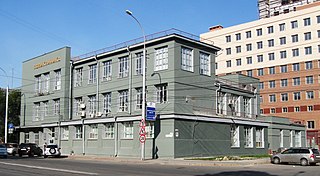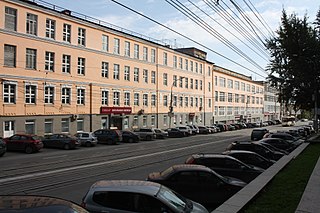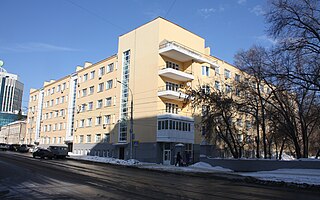
The Stadion Dynamo imeni Valeria Lobanovskoho is a multi-functional stadium in Kyiv, Ukraine that is modified for football use only.

Constructivist architecture was a constructivist style of modern architecture that flourished in the Soviet Union in the 1920s and early 1930s. Abstract and austere, the movement aimed to reflect modern industrial society and urban space, while rejecting decorative stylization in favor of the industrial assemblage of materials. Designs combined advanced technology and engineering with an avowedly communist social purpose. Although it was divided into several competing factions, the movement produced many pioneering projects and finished buildings, before falling out of favour around 1932. It has left marked effects on later developments in architecture.

The National Museum-Memorial of Victims of the Occupation Regimes, or the Prison on Łącki (Street) is a former detention center in Lviv that throughout the 20th century was primarily used as a political prison of the Polish, Soviet and Nazi regimes.

Tsentralny District is an administrative district (raion) of Central Okrug, one of the 10 raions of Novosibirsk, Russia. The area of the district is 6.4 sq km. Population: 78 794 (2017).

The Polyclinic No. 1 is a constructivist building designed by P. Shchyokin. It is located on Serebrennikovskaya Street in the Tsentralny City District of Novosibirsk, Russia.

Serebrennikovskaya Street is a street in Tsentralny City District of Novosibirsk, Russia. It runs south-north. The street starts from the Altay Railway Overpass and ends near the southern facade of the Novosibirsk Opera and Ballet Theatre.

The House of Socialist Agriculture is a building in Tsentralny City District of Novosibirsk, Russia. It is located between Gorky Street, Oktyabrskaya Magistral and Krasny Avenue. The building was designed by architect Nikolay Kuzmin.

Chaplygin Street is a street in Zheleznodorozhny and Tsentralny districts of Novosibirsk, Russia. The street consists of two fragments. The first street fragment starts from Street of Revolution, crosses Uritsky, Sovetskaya streets and forms a T-intersection with Krasny Avenue. The second fragment starts from Serebrennikovskaya Street crosses Kamenskaya Street and ends in a city block.

Maxim Gorky Street is an east-west street in Zheleznodorozhny and Tsentralny districts of Novosibirsk, Russia. The street starts from nameless passage connecting Gorky Street with Dimitrov Avenue, crosses Street of Revolution, Uritsky and Sovetskaya streets, Krasny Avenue, Serebrennikovskaya, Kamenskaya and Shamshin Family streets. The street ends in city block opposite the Aura Mall.

Michurin Street is a street in Tsentralny City District of Novosibirsk, Russia. It runs south-north. The street starts from Ordzhonikidze Street opposite the Novosibirsk Opera and Ballet Theatre, crosses Yadrintsevskaya, Frunze, Krylov, Gogol streets and then forms a T-intersection with Pisarev Street.

Kuzbassugol Building Complex is a building complex located in the Tsentralny City District of Novosibirsk, Russia. It was built in 1931–1933. Architects: B. A. Gordeyev, D. A. Ageyev, B. A. Bitkin.

Sibrevcom Street is a west-east street in Tsentralny City District of Novosibirsk, Russia. It runs from a T-intersection with Krasny Avenue, crosses Serebrennikovskaya Street and ends near the Sibrevcomovsky Bridge over Ippodromskaya Street.

Lenin Street is a street in Tsentralny and Zheleznodorozhny districts of Novosibirsk, Russia. It starts from Krasny Avenue, runs west, crosses Sovetskaya and Uritsky streets, Street of Revolution, forms a crossroad with Dimitrov Avenue, then turns north-west, crosses Komsomolsky Avenue, 1905 Year Street and forms a crossroads with Dmitry Shamshurin and Zheleznodorozhny streets.

NKVD House is a constructivist building in Tsentralny City District of Novosibirsk, Russia. It was built in 1932. Architects: Ivan Voronov, Boris Gordeyev.

House of Artists is a building in Tsentralny City District of Novosibirsk, Russia. It is located on Romanov Street. The house was built in the 1930s. Architects: B. A. Gordeyev, S. P. Turgenev.

Business House is a constructivist building in Tsentralny City District of Novosibirsk, Russia. It is located on the corner of Krasny Avenue and Lenin Street. The building is a part of the architectural ensemble of Lenin Square. It was built in 1928. Architects: D. F. Fridman, I. A. Burlakov.

Kryukov House is a building in Zheleznodorozhny City District of Novosibirsk, Russia, built in 1908. It is located on the corner of Sovetskaya and Gorky streets. The house originally belonged to the merchant Zakhary Grigoryevich Kryukov.

Bolshevistskaya Street is a street in Oktyabrsky City District of Novosibirsk, Russia. It starts from the road junction called Engineer Budagov Square, runs southeast along the right bank of the Ob River and ends near the bridge over the Inya River. The length of the street is more than 7 km.

October Revolution House of Culture is a constructivist building in Zheleznodorozhny City District of Novosibirsk, Russia. It was built in 1927. The building is located on the corner of Lenin and Revolution streets. Architect: I. A. Burlakov.

Dinamo Residential Complex is a constructivist building complex in Tsentralny City District of Novosibirsk, Russia. It is located on the corner of Krasny Avenue and Oktyabrskaya Street. The complex was built in 1934–1936. Architects: Boris Gordeyev, S. P. Turgenev, V. N. Nikitin. It included a hotel and residential buildings for NKVD employees.





















